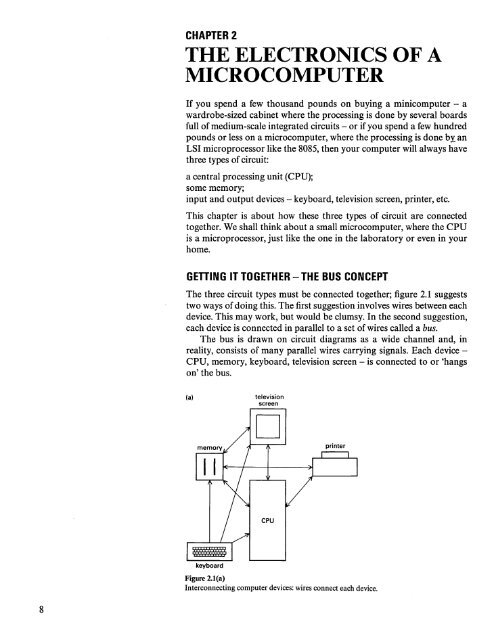Microcomputer Circuits and Processes
Microcomputer Circuits and Processes
Microcomputer Circuits and Processes
Create successful ePaper yourself
Turn your PDF publications into a flip-book with our unique Google optimized e-Paper software.
CHAPTER 2<br />
THE ELECTRONICS<br />
MICROCOMPUTER<br />
OF A<br />
If you spend a few thous<strong>and</strong> pounds on buying a minicomputer - a<br />
wardrobe-sized cabinet where the processing is done by several boards<br />
full of medium-scale integrated circuits - or if you spend a few hundred<br />
pounds or less on a microcomputer, where the processing is done by"an<br />
LSI microprocessor like the 8085, then your computer will always have<br />
three types of circuit:<br />
a central processing unit (CPU);<br />
some memory;<br />
input <strong>and</strong> output devices - keyboard, television screen, printer, etc.<br />
This chapter is about how these three types of circuit are connected<br />
together. We shall think about a small microcomputer, where the CPU<br />
is a microprocessor, just like the one in the laboratory or even in your<br />
home.<br />
GETTING IT TOGETHER - THE BUS CONCEPT<br />
The three circuit types must be connected together; figure 2.1 suggests<br />
two ways of doing this. The first suggestion involves wires between each<br />
device. This may work, but would be clumsy. In the second suggestion,<br />
each device is connected in parallel to a set of wires called a bus.<br />
The bus is drawn on circuit diagrams as a wide channel <strong>and</strong>, in<br />
reality, consists of many parallel wires carrying signals. Each device -<br />
CPU, memory, keyboard, television screen - is connected to or 'hangs<br />
on' the bus.<br />
(a)<br />
television<br />
screen<br />
D<br />
printer<br />
cPU<br />
Figure<br />
2.1(a)<br />
Interconnecting computer devices: wires connect each device.<br />
8











